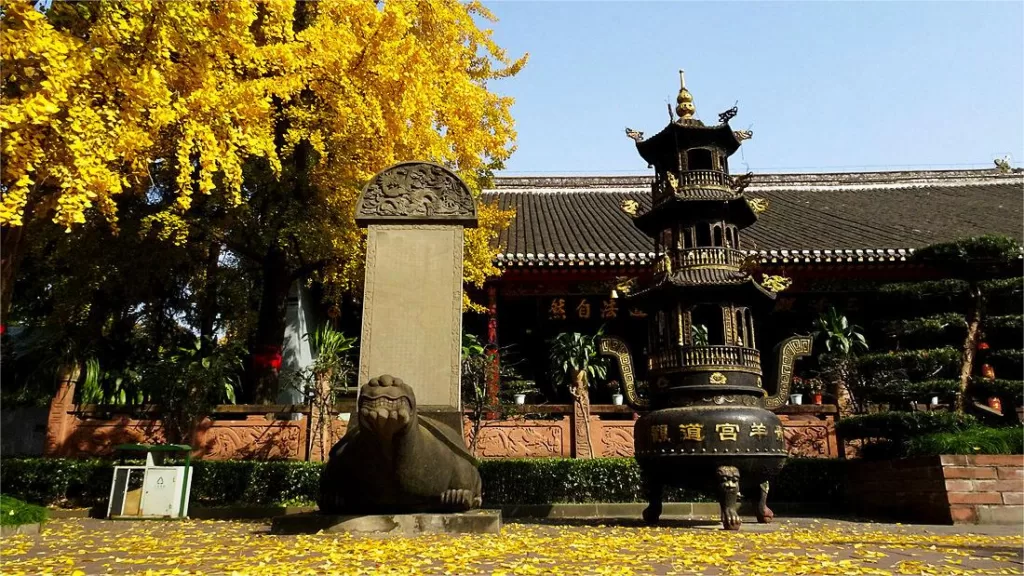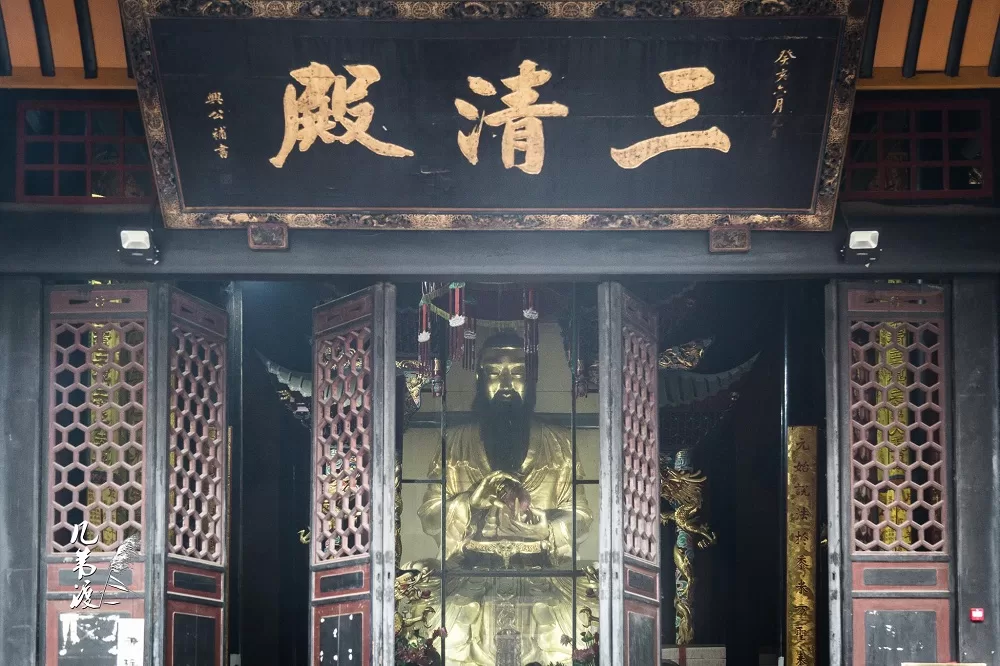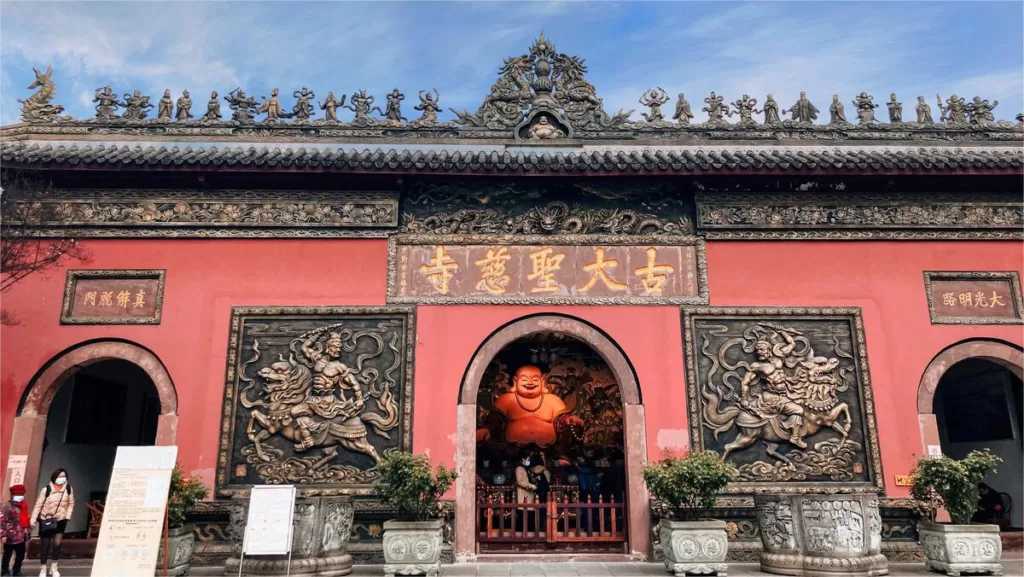Qingyang-Palast, Chengdu - Tickets, Öffnungszeiten, Highlights und Tipps


Qingyang Palace (青羊宫) is a Taoist temple located in the heart of Chengdudie Hauptstadt der Provinz Sichuan in southwestern China. It is one of the oldest and most famous Taoist temples in the region, with a history that dates back over 2,000 years.
The temple was first built during the Zhou Dynasty (1046 BC – 256 BC) and has undergone numerous renovations and expansions over the centuries. Today, it covers an area of over 10,000 square meters and consists of multiple halls, courtyards, and gardens.
Qingyang Palace is renowned for its beautiful architecture, which blends traditional Chinese design elements with Taoist symbolism. The most notable structures within the temple include the Hall of Three Purities, the Hall of the Heavenly Kings, and the Sanqing Hall.
In addition to its cultural and historical significance, Qingyang Palace is also a popular destination for tourists and locals alike. Visitors can participate in various religious activities, such as burning incense and praying for good fortune, or simply admire the temple’s stunning beauty and serene atmosphere.
Overall, Qingyang Palace is a must-visit destination for anyone interested in Chinese history, culture, and religion. Its rich heritage and stunning architecture make it a true gem of Chengdu and a testament to the enduring legacy of Taoism in China.
Inhaltsübersicht
- Grundlegende Informationen
- Standort und Transport
- Highlights of Qingyang Palace
- Vlog about Qingyang Palace
- Nützliche Tipps aus echten Rezensionen
- Attractions Near Qingyang Palace
- Andere Tempel in Chengdu
Grundlegende Informationen
| Geschätzte Dauer der Tour | 1 Stunde |
| Ticketpreis | 10 RMB |
| Die Öffnungszeiten | 6.00 – 17.30 |
| Telefon Nummer | 0086-028-87766584 |
Standort und Transport
Qingyang Palace is located in the central district of Chengdu, the capital city of Sichuan Province in southwestern China. Its address is No. 9, West Section 2, Qingyang Road, Qingyang District, Chengdu, Sichuan Province, China. The temple is easily accessible by public transportation.
Bus: Take bus 34, 35, 58, 82, 151, 165, 280, 1031, or 1079 and get off at Qingyang Palace Stop (青羊宫站).
U-Bahn: Take subway line 5, get off at Qingyang Palace Station (青羊宫站), and get out from Exit C.
Highlights of Qingyang Palace
Hall of Three Purities

The Hall of Three Purities is the main hall of Qingyang Palace. It was built during the Ming Dynasty and has undergone several renovations over the centuries. The hall is dedicated to the three highest deities of Taoism: Yuanshi Tianzun, Lingbao Tianzun, and Daode Tianzun. It features a stunning gold-plated roof and intricate woodcarvings depicting Taoist legends and symbols. Inside, visitors can see the three statues of the deities, each seated on a lotus throne.
The Laozi Pavilion

The Laozi Pavilion in Qingyang Palace was built in the Tang Dynasty and is dedicated to Laozi, the founder of Taoism. The pavilion has undergone several renovations over the centuries and features a traditional Chinese architectural style with a unique hexagonal shape. The pavilion houses a statue of Laozi, as well as a number of Taoist scriptures and artifacts. Visitors to Qingyang Palace can admire the pavilion’s intricate woodcarvings and detailed paintings, and learn about the fascinating history and philosophy of Taoism in China.
Eight Trigram Pavilion

The Eight Trigram Pavilion in Qingyang Palace was built in the Qing Dynasty and is dedicated to the Eight Trigrams of the I Ching, an ancient Chinese divination system. The pavilion is surrounded by a tranquil lotus pond, and visitors can walk around it to admire its intricate carvings and colorful decorations. The pavilion is considered a symbol of Taoist philosophy, representing the balance of yin and yang, and the harmony between humanity and nature.
Qingyang Palace Fair

The Qingyang Palace Fair is an annual event held on the 15th day of the fourth lunar month. The fair is a celebration of Taoist culture and traditions, and attracts large crowds of locals and tourists alike. It features a wide variety of activities, including dragon and lion dances, street performances, and cultural exhibitions. Visitors can also enjoy local snacks and browse through a variety of souvenir and handicraft stalls. The Qingyang Palace Fair offers a fascinating glimpse into the rich history and vibrant culture of Taoism in China, and is a must-visit for anyone interested in traditional Chinese festivals and celebrations.
Vlog about Qingyang Palace
Nützliche Tipps aus echten Rezensionen
Famous Bronze Rams: The most famous attraction at Qingyang Palace is the pair of bronze rams in front of the Sanqing Hall. According to folklore, rubbing the corresponding body parts of the bronze ram to where you feel discomfort is believed to cure ailments.
Vegetarian Meals: Within Qingyang Palace’s tea garden, there’s a vegetarian meal service starting at 11:30 am. Priced at 15 yuan, it includes four vegetarian dishes and rice. After the meal, you can also enjoy a cup of tea nearby.
Sanqing Hall: This is where the temple conducts morning and evening rituals, typically at 4 pm daily. If coincidentally there’s a chanting session, it’s essential to maintain silence. If you follow the faith, joining in is acceptable. Avoid wandering around or creating noise during this time.
Attractions Near Qingyang Palace

Breite und schmale Gassen - Drei historische Gassen mit unterschiedlichen Merkmalen

People's Park - Der beste Ort, um das lokale Leben zu erleben

Chengdu Museum - Ein auf die Kultur von Chengdu spezialisiertes Museum

Kunstmuseum Sichuan - Eine umfassende Galerie

Shu Feng Ya Yun Sichuan Opera House - Genießen Sie die lokale Oper

Baihuatan Park - Ein Park für die Einheimischen

Wenshu-Yuan-Kloster - Der größte Tempel in Chengdu

Chengdu Sichuan Tapestry Woven And Embroidered Museum - Präsentation eines der Luxusgüter des alten China
Andere Tempel in Chengdu

Wenshu Monastery – An efficacious praying place

Daci-Tempel - Ein Tang-Dynastie-Tempel im Stadtzentrum

Zhaojue-Tempel - Ein international einflussreicher Tempel
Chengdu Attraktionen, Historische Stätte in Sichuan